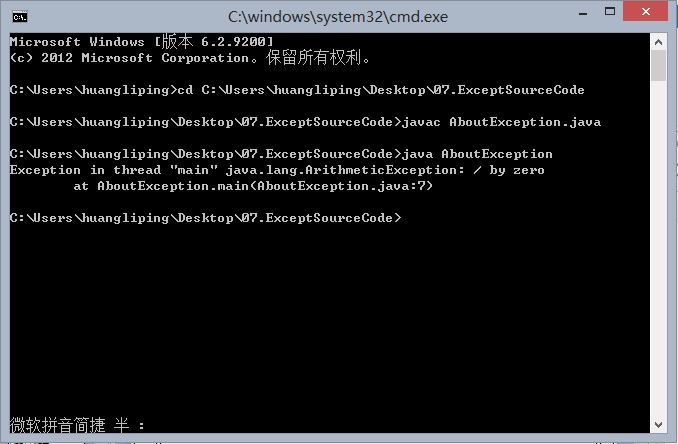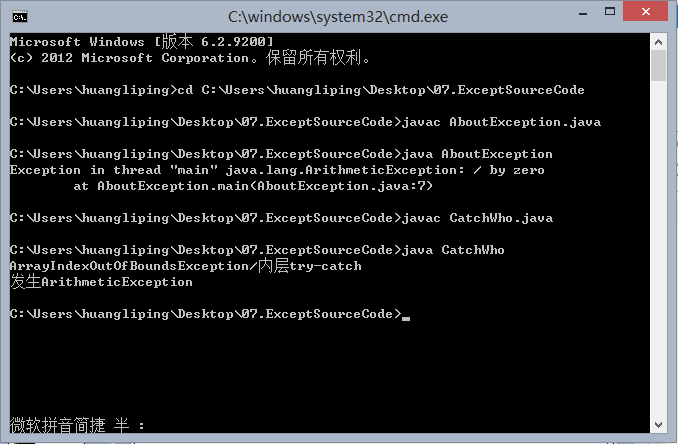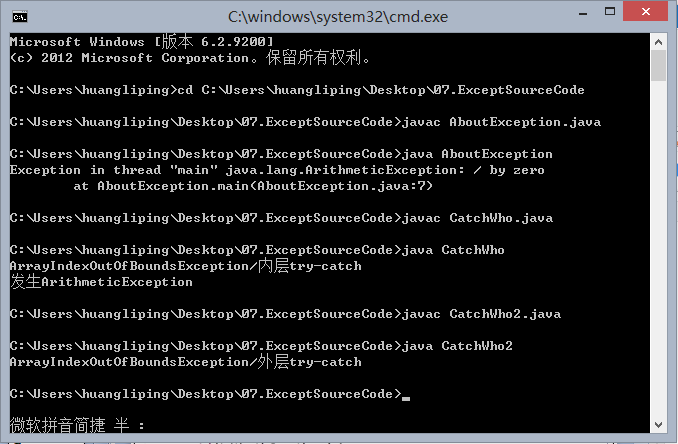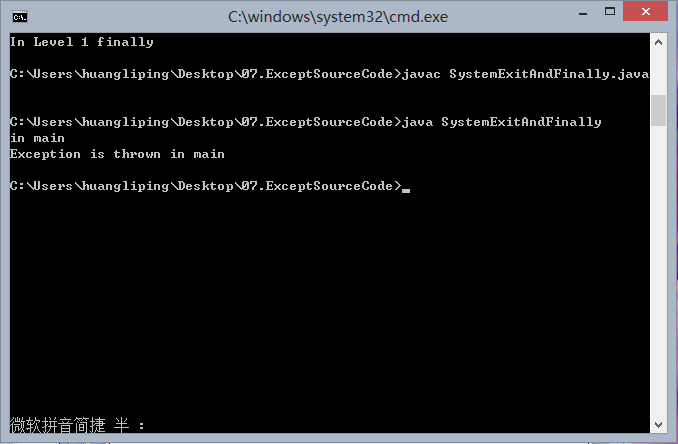一、运行课件中的例题ParentChildTest.java,回答下列问题:
a、左边的结果运行结果是什么?
运行结果截图为:

b、你如何解释会得到这样的输出?
第一个值:父类Parent调用自己的方法;
第二个值:子类child调用方自己的方法;
第三个值:子类将自己的方法赋给父类,因而实际调用的是子类的方法;
第四个值:父类中的值MyValue加一,但是父类调用的是子类的方法,因而无影响;
第五个值:强制转化,父类将值赋给子类,调用的仍然是子类的方法,只是值加一
c、计算机是不会出错的,之所以会得到这样的运行结果也是有原因的,那么从运行结果当中,你能总结出java的那些语法特征?
① 用类名进行赋值时(如parent=child ),附的都是方法;
② 对类中的值进行赋值时需要用类名.对象;
③ 父类对子类进行赋值时需要强制转化;
(1)、并修改ParentChildTest.java,验证你的回答结果。
验证程序代码如下:
public class ParentChileTest {
public static void main(String[] args) {
Parent parent=new Parent();
parent.printValue();
Child child=new Child();
child.printValue();
parent=child;
parent.printValue();
parent.myValue ++;
System.out.println(parent.myValue);
System.out.println(child.myValue);
parent.printValue();
((Child)parent).myValue++;
System.out.println(parent.myValue);
System.out.println(child.myValue);
parent.printValue();
}
}
class Parent{
public int myValue=100;
public void printValue() {
System.out.println("Parent.printValue(),myValue="+myValue);
}
}
class Child extends Parent{
public int myValue=200;
public void printValue() {
System.out.println("Child.printValue(),myValue="+myValue);
}
}
截图:

二、请阅读并运行AboutException.java示例,然后通过后面的几页PPT了解Java中实现异常处理的基础知识
实验代码为:
import javax.swing.*;
class AboutException {
public static void main(String[] a)
{
int i=1, j=0, k;
k=i/j;
try
{
k = i/j; // Causes division-by-zero exception
//throw new Exception("Hello.Exception!");
}
catch ( ArithmeticException e)
{
System.out.println("被0除. "+ e.getMessage());
}
catch (Exception e)
{
if (e instanceof ArithmeticException)
System.out.println("被0除");
else
{
System.out.println(e.getMessage());
}
}
finally
{
JOptionPane.showConfirmDialog(null,"OK");
}
}
}
实验截图为:

使用Java异常处理的机制:
把可能会发生错误的代码放进try语句块中。
当程序检测到出现了一个错误时会抛出一个异常对象。异常处理代码会捕获并处理这个错误。catch语句块中的代码用于处理错误。
当异常发生时,程序控制流程由try语句块跳转到catch语句块。
不管是否有异常发生,finally语句块中的语句始终保证被执行。
如果没有提供合适的异常处理代码,JVM将会结束掉整个应用程序。
三、多层的异常捕获-1
阅读下面代码,写出程序的运行结果:
public class CatchWho {
public static void main(String[] args) {
try {
try {
throw new ArrayIndexOutOfBoundsException();
}
catch(ArrayIndexOutOfBoundsException e) {
System.out.println( "ArrayIndexOutOfBoundsException" + "/内层try-catch");
}
throw new ArithmeticException();
}
catch(ArithmeticException e) {
System.out.println("发生ArithmeticException");
}
catch(ArrayIndexOutOfBoundsException e) {
System.out.println( "ArrayIndexOutOfBoundsException" + "/外层try-catch");
}
}
}
输出结果为:ArrayIndexOutOfBoundsException内层try-catch
发生ArithmeticException
截图为:

四、写出下列程序的运行结果:
public class CatchWho2 {
public static void main(String[] args) {
try {
try {
throw new ArrayIndexOutOfBoundsException();
}
catch(ArithmeticException e) {
System.out.println( "ArrayIndexOutOfBoundsException" + "/内层try-catch");
}
throw new ArithmeticException();
}
catch(ArithmeticException e) {
System.out.println("发生ArithmeticException");
}
catch(ArrayIndexOutOfBoundsException e) {
System.out.println( "ArrayIndexOutOfBoundsException" + "/外层try-catch");
}
}
}
预测结果为:ArrayIndexOutOfBoundsException" + "/外层try-catch
结果截图:
五、当有多个嵌套的try…catch…finally时,要特别注意finally的执行时机。
请先阅读 EmbedFinally.java示例,再运行它,观察其输出并进行总结。
特别注意:当有多层嵌套的finally时,异常在不同的层次抛出 ,在不同的位置抛出,可能会导致不同的finally语句块执行顺序。
实例:
public class EmbededFinally {
public static void main(String args[]) {
int result;
try {
System.out.println("in Level 1");
try {
System.out.println("in Level 2");
// result=100/0; //Level 2
try {
System.out.println("in Level 3");
result=100/0; //Level 3
}
catch (Exception e) {
System.out.println("Level 3:" + e.getClass().toString());
}
finally {
System.out.println("In Level 3 finally");
}
// result=100/0; //Level 2
}
catch (Exception e) {
System.out.println("Level 2:" + e.getClass().toString());
}
finally {
System.out.println("In Level 2 finally");
}
// result = 100 / 0; //level 1
}
catch (Exception e) {
System.out.println("Level 1:" + e.getClass().toString());
}
finally {
. System.out.println("In Level 1 finally");
}
}
}
运行结果截图为:

总结:第一个finally之前的catch都运行,之后只运行finally。
六、finally语句块一定会执行吗?请通过下面的程序回答:
public class SystemExitAndFinally {
public static void main(String[] args)
{
try
{
System.out.println("in main");
throw new Exception("Exception is thrown in main");
//System.exit(0);
}
catch(Exception e)
{
System.out.println(e.getMessage());
System.exit(0);
}
finally
{
System.out.println("in finally");
}
}
}
运行结果截图:

Finally不一定都要执行,系统遇到System.Exit(0)是便会中止;
try、catch、finally的关系:try快不能单独存在,后面必须跟catch块或者finally;三者之间的组合为:try-finally .try-catch .try-catch-finally这几种是合法的;一个try快可以有多个catch,从上到下catch的范围是从小到大。
七、编写一个程序,此程序在运行时要求用户输入一个 整数,代表某门课的考试成绩,程序接着给出“不及格”、“及格”、“中”、“良”、“优”的结论。(要求程序必须具备足够的健壮性,不管用户输入什 么样的内容,都不会崩溃。)
源代码为:
import java.util.Scanner;
import javax.swing.JOptionPane;
public class Grade {
public static void main(String[] args) {
// TODO 自动生成的方法存根
double i;
for(;;)
{
Scanner in = new Scanner(System.in);
try{
System.out.println("请输入成绩:(0-100)");
i = in.nextInt();
if(i<0||i>100)
{System.out.println("您输入的信息有误!");break;}
if(i>=0&&i<60)
{System.out.println("不及格!");break;}
if(i>=60&&i<70)
{System.out.println("及格");break;}
if(i>=70&&i<80)
{System.out.println("中");break;}
if(i>=80&&i<90)
{System.out.println("良");break;}
if(i>=90&&i<=100)
{System.out.println("优秀!");break;}
}
catch(Exception e)
{
System.out.println("您输入的信息有误!");
}
}
}
}
运行结果截图:


